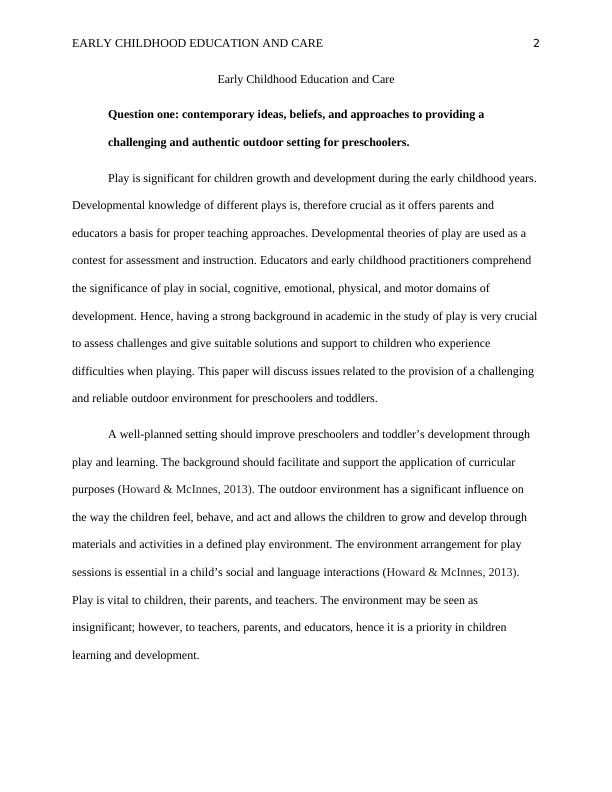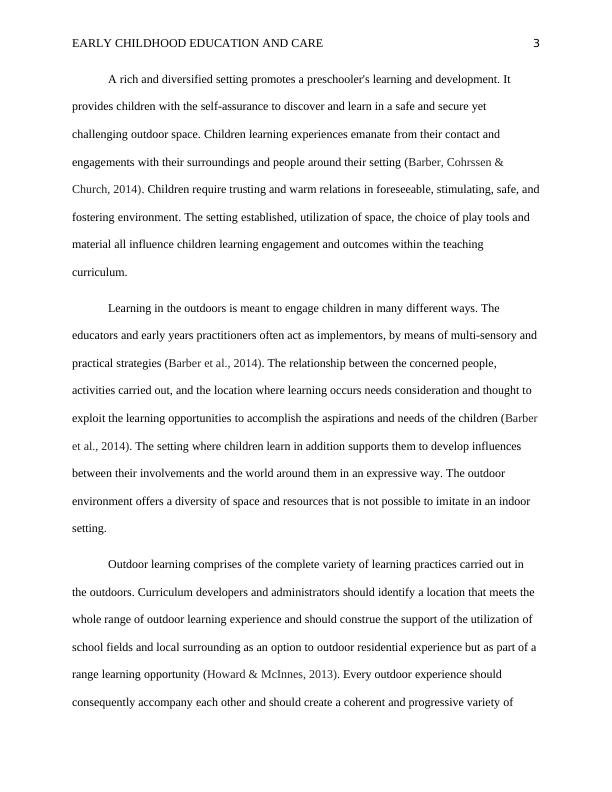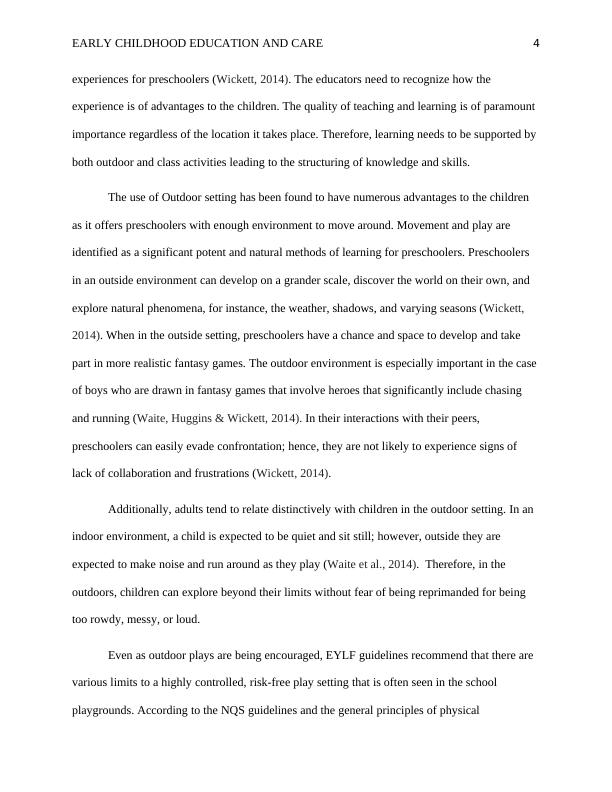Early Childhood Education and Care
Added on 2022-11-14
13 Pages3875 Words149 Views
Running head: EARLY CHILDHOOD EDUCATION AND CARE 1
Early Childhood Education and Care
Student’s Name
Institution Affiliation
Early Childhood Education and Care
Student’s Name
Institution Affiliation

EARLY CHILDHOOD EDUCATION AND CARE 2
Early Childhood Education and Care
Question one: contemporary ideas, beliefs, and approaches to providing a
challenging and authentic outdoor setting for preschoolers.
Play is significant for children growth and development during the early childhood years.
Developmental knowledge of different plays is, therefore crucial as it offers parents and
educators a basis for proper teaching approaches. Developmental theories of play are used as a
contest for assessment and instruction. Educators and early childhood practitioners comprehend
the significance of play in social, cognitive, emotional, physical, and motor domains of
development. Hence, having a strong background in academic in the study of play is very crucial
to assess challenges and give suitable solutions and support to children who experience
difficulties when playing. This paper will discuss issues related to the provision of a challenging
and reliable outdoor environment for preschoolers and toddlers.
A well-planned setting should improve preschoolers and toddler’s development through
play and learning. The background should facilitate and support the application of curricular
purposes (Howard & McInnes, 2013). The outdoor environment has a significant influence on
the way the children feel, behave, and act and allows the children to grow and develop through
materials and activities in a defined play environment. The environment arrangement for play
sessions is essential in a child’s social and language interactions (Howard & McInnes, 2013).
Play is vital to children, their parents, and teachers. The environment may be seen as
insignificant; however, to teachers, parents, and educators, hence it is a priority in children
learning and development.
Early Childhood Education and Care
Question one: contemporary ideas, beliefs, and approaches to providing a
challenging and authentic outdoor setting for preschoolers.
Play is significant for children growth and development during the early childhood years.
Developmental knowledge of different plays is, therefore crucial as it offers parents and
educators a basis for proper teaching approaches. Developmental theories of play are used as a
contest for assessment and instruction. Educators and early childhood practitioners comprehend
the significance of play in social, cognitive, emotional, physical, and motor domains of
development. Hence, having a strong background in academic in the study of play is very crucial
to assess challenges and give suitable solutions and support to children who experience
difficulties when playing. This paper will discuss issues related to the provision of a challenging
and reliable outdoor environment for preschoolers and toddlers.
A well-planned setting should improve preschoolers and toddler’s development through
play and learning. The background should facilitate and support the application of curricular
purposes (Howard & McInnes, 2013). The outdoor environment has a significant influence on
the way the children feel, behave, and act and allows the children to grow and develop through
materials and activities in a defined play environment. The environment arrangement for play
sessions is essential in a child’s social and language interactions (Howard & McInnes, 2013).
Play is vital to children, their parents, and teachers. The environment may be seen as
insignificant; however, to teachers, parents, and educators, hence it is a priority in children
learning and development.

EARLY CHILDHOOD EDUCATION AND CARE 3
A rich and diversified setting promotes a preschooler's learning and development. It
provides children with the self-assurance to discover and learn in a safe and secure yet
challenging outdoor space. Children learning experiences emanate from their contact and
engagements with their surroundings and people around their setting (Barber, Cohrssen &
Church, 2014). Children require trusting and warm relations in foreseeable, stimulating, safe, and
fostering environment. The setting established, utilization of space, the choice of play tools and
material all influence children learning engagement and outcomes within the teaching
curriculum.
Learning in the outdoors is meant to engage children in many different ways. The
educators and early years practitioners often act as implementors, by means of multi-sensory and
practical strategies (Barber et al., 2014). The relationship between the concerned people,
activities carried out, and the location where learning occurs needs consideration and thought to
exploit the learning opportunities to accomplish the aspirations and needs of the children (Barber
et al., 2014). The setting where children learn in addition supports them to develop influences
between their involvements and the world around them in an expressive way. The outdoor
environment offers a diversity of space and resources that is not possible to imitate in an indoor
setting.
Outdoor learning comprises of the complete variety of learning practices carried out in
the outdoors. Curriculum developers and administrators should identify a location that meets the
whole range of outdoor learning experience and should construe the support of the utilization of
school fields and local surrounding as an option to outdoor residential experience but as part of a
range learning opportunity (Howard & McInnes, 2013). Every outdoor experience should
consequently accompany each other and should create a coherent and progressive variety of
A rich and diversified setting promotes a preschooler's learning and development. It
provides children with the self-assurance to discover and learn in a safe and secure yet
challenging outdoor space. Children learning experiences emanate from their contact and
engagements with their surroundings and people around their setting (Barber, Cohrssen &
Church, 2014). Children require trusting and warm relations in foreseeable, stimulating, safe, and
fostering environment. The setting established, utilization of space, the choice of play tools and
material all influence children learning engagement and outcomes within the teaching
curriculum.
Learning in the outdoors is meant to engage children in many different ways. The
educators and early years practitioners often act as implementors, by means of multi-sensory and
practical strategies (Barber et al., 2014). The relationship between the concerned people,
activities carried out, and the location where learning occurs needs consideration and thought to
exploit the learning opportunities to accomplish the aspirations and needs of the children (Barber
et al., 2014). The setting where children learn in addition supports them to develop influences
between their involvements and the world around them in an expressive way. The outdoor
environment offers a diversity of space and resources that is not possible to imitate in an indoor
setting.
Outdoor learning comprises of the complete variety of learning practices carried out in
the outdoors. Curriculum developers and administrators should identify a location that meets the
whole range of outdoor learning experience and should construe the support of the utilization of
school fields and local surrounding as an option to outdoor residential experience but as part of a
range learning opportunity (Howard & McInnes, 2013). Every outdoor experience should
consequently accompany each other and should create a coherent and progressive variety of

EARLY CHILDHOOD EDUCATION AND CARE 4
experiences for preschoolers (Wickett, 2014). The educators need to recognize how the
experience is of advantages to the children. The quality of teaching and learning is of paramount
importance regardless of the location it takes place. Therefore, learning needs to be supported by
both outdoor and class activities leading to the structuring of knowledge and skills.
The use of Outdoor setting has been found to have numerous advantages to the children
as it offers preschoolers with enough environment to move around. Movement and play are
identified as a significant potent and natural methods of learning for preschoolers. Preschoolers
in an outside environment can develop on a grander scale, discover the world on their own, and
explore natural phenomena, for instance, the weather, shadows, and varying seasons (Wickett,
2014). When in the outside setting, preschoolers have a chance and space to develop and take
part in more realistic fantasy games. The outdoor environment is especially important in the case
of boys who are drawn in fantasy games that involve heroes that significantly include chasing
and running (Waite, Huggins & Wickett, 2014). In their interactions with their peers,
preschoolers can easily evade confrontation; hence, they are not likely to experience signs of
lack of collaboration and frustrations (Wickett, 2014).
Additionally, adults tend to relate distinctively with children in the outdoor setting. In an
indoor environment, a child is expected to be quiet and sit still; however, outside they are
expected to make noise and run around as they play (Waite et al., 2014). Therefore, in the
outdoors, children can explore beyond their limits without fear of being reprimanded for being
too rowdy, messy, or loud.
Even as outdoor plays are being encouraged, EYLF guidelines recommend that there are
various limits to a highly controlled, risk-free play setting that is often seen in the school
playgrounds. According to the NQS guidelines and the general principles of physical
experiences for preschoolers (Wickett, 2014). The educators need to recognize how the
experience is of advantages to the children. The quality of teaching and learning is of paramount
importance regardless of the location it takes place. Therefore, learning needs to be supported by
both outdoor and class activities leading to the structuring of knowledge and skills.
The use of Outdoor setting has been found to have numerous advantages to the children
as it offers preschoolers with enough environment to move around. Movement and play are
identified as a significant potent and natural methods of learning for preschoolers. Preschoolers
in an outside environment can develop on a grander scale, discover the world on their own, and
explore natural phenomena, for instance, the weather, shadows, and varying seasons (Wickett,
2014). When in the outside setting, preschoolers have a chance and space to develop and take
part in more realistic fantasy games. The outdoor environment is especially important in the case
of boys who are drawn in fantasy games that involve heroes that significantly include chasing
and running (Waite, Huggins & Wickett, 2014). In their interactions with their peers,
preschoolers can easily evade confrontation; hence, they are not likely to experience signs of
lack of collaboration and frustrations (Wickett, 2014).
Additionally, adults tend to relate distinctively with children in the outdoor setting. In an
indoor environment, a child is expected to be quiet and sit still; however, outside they are
expected to make noise and run around as they play (Waite et al., 2014). Therefore, in the
outdoors, children can explore beyond their limits without fear of being reprimanded for being
too rowdy, messy, or loud.
Even as outdoor plays are being encouraged, EYLF guidelines recommend that there are
various limits to a highly controlled, risk-free play setting that is often seen in the school
playgrounds. According to the NQS guidelines and the general principles of physical

End of preview
Want to access all the pages? Upload your documents or become a member.
Related Documents
Early Childhood Curriculum: Literature Review and Matrixlg...
|29
|5989
|313
Communication Methods For Early Childhoodlg...
|24
|810
|27
Environment in Early Childhood Settingslg...
|10
|2270
|395
Infants and Toddlers Reportlg...
|8
|1613
|17
Literacy and Numeracy in the Education of Young Childrenlg...
|13
|3464
|81
Early Childhood Education and Care Using an integrated curriculum approachlg...
|12
|2755
|348
